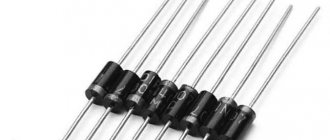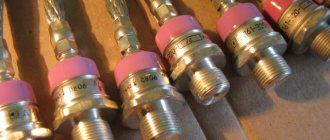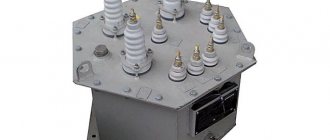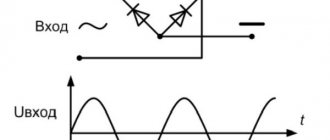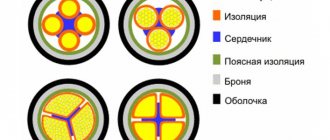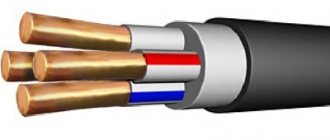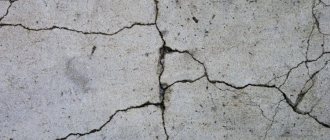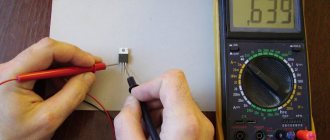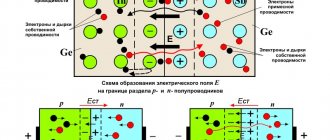Specifications
As you can imagine, 1N4007 is one of the most popular diodes used today.
It is used in many chargers for modern phone devices, even those that cost about a dollar and do not have stabilizers or filters to reduce interference. Devices cannot do without 1N4007. There are exactly four of them in one adapter, on which a diode bridge is assembled using 1n4007, which, in fact, converts alternating current into direct current, transferring the current through itself in only one direction, completely cutting off one of the existing polarities of the entire voltage.
Diode sizes
At the same time, in cheap similar chargers, some manufacturers save these diodes by using 1 instead of 4, replacing them with half-wave rectification. It is strongly recommended to use the first option, with a total voltage of more than 1 Watt.
Normal diodes are not able to resist a reverse current avalanche, since they are made specifically to withstand the flow of energy flowing through this element. The cathode output is indicated on the body part with a special ring.
Below you can see the electrical and thermal characteristics of the 1n4007.
Electrical characteristics
The electrical characteristics include parameters such as forward voltage, as well as reverse current, total capacitance, maximum reverse current with a certain load, as well as the average value of the rectifying current and peak repeating reverse voltage.
- Forward voltage (VF) at 1.0A - 1.1 V.
- Reverse current at 25°C - 5 μA.
- The total capacitance at 1.0 MHz is 15 pF.
- Maximum full load reverse current at 75 °C is 30 μA.
- The average rectified forward current (IF (AV)) is 1A.
- Peak repetitive reverse voltage 1n4007 1a 1000v.
The diode has a high overload capacity, as well as a low voltage drop, which can have a peak value of up to 1.1 V. The maximum pulse current has a duration of 8.2 seconds, reaching a voltage of 30A.
As already indicated above, the typical electrical capacitance of the junction should not exceed about 15 pF. This is all taken into account when using a frequency of 1 MHz, and a constant voltage of 4V. Speaking in theory, the speed of the diode is unacceptable, so they are not in demand for high-frequency purposes, since this is not regulated.
The leakage current will not exceed 5 μA, but if a progressive increase in the ambient temperature is noticed, this figure will also increase. For example, at temperatures above 75 degrees, you can be sure that it will increase to 50 µA. As a result, performance indicators deteriorate, which is why for effective use you must use a standard 30% margin of the parameters. In addition, cooling should be properly organized, which is carried out using a non-conducting thermal compound.
Thermal characteristics of 1N4007
Thermal characteristics include power dissipation as well as resistivity as the main ones. Both the above characteristics have the following meanings as given below.
- Thermal resistance - 50 °C/W.
- Power dissipation - 3 W.
Installation 1N-4007
1n5819 diode: characteristics
The part is installed on the board in the same way as any other two-pin elements. The algorithm of actions is as follows:
- Using special needles and a soldering iron, the mounting holes for the part are cleaned of old solder. It is even more convenient to use a tin pump.
- The diode leads are inserted into the holes according to polarity. It is indicated both on the board and on the part itself.
- The diode is pressed closely to the board. On the other side, the leads are bent. This is necessary to secure the part before soldering.
- The leads are soldered to the contact pads. Excess sections are shortened to the minimum length.
Description and application of 1N-4007
Externally, 1N-4007 is a small black cylinder. It consists of a polymer resin used in the manufacture of most such elements. A semiconductor crystal is hidden inside. Its basis is monocrystalline silicon, obtained from sand through extremely high-tech technical processes.
There are two electrical terminals on the sides of the diode. Their task is to conduct current from the crystal to the board into which this part is soldered. The leads are made of copper and covered with a thin layer of solder, i.e. they're cheating.
Additional Information. Diodes are designed to pass electric current in one direction, i.e. from anode (+) to cathode (-). Their hydraulic analogue is a valve. This property is inherent in this part at the level of the silicon crystal lattice from which it is produced. There are also diodes based on germanium, but at the moment they are practically not used.
The 1N4007 diode is an ideal tool for building powerful rectifier bridges
The 1N4007 diode is a high-power semiconductor device that is most commonly used in power supplies. To be more precise, in their rectifier part, that is, in the diode bridge. Its main task is to convert alternating voltage into direct voltage, on which most microelectronic components operate today. The principle of operation of the diode is as follows. It is open in one direction, and the signal passes through it without problems. If you change the polarity of the signal, it will close and practically nothing will pass through.
The 1N4007 diode is produced in Taiwan. In this case, the production capacities of DIODES and RECTRON SEMICONDACTOR companies are used. There are also products from other brands, but much less frequently.
Characteristics
The main characteristics of the 1N4007 diode are as follows:
- weight 0.35 g;
- maximum soldering temperature 250 degrees Celsius for no more than 10 seconds;
- the cathode is indicated by a special ring, which is applied to the body;
- maximum (also called “peak”) voltage – no more than 1000 V;
- operating temperature range ranges from -55 to +125 degrees Celsius;
- the maximum current through the device should not exceed 1 A;
- The maximum voltage drop with an open pn junction is no more than 1 V at a current value of 1 A.
If you pay attention to the highest permissible potential value, you can understand that this is a powerful diode that will easily operate with 220 or 380 V. Based on this, we can say that it was originally developed for power supplies
The 1N4007 diode can most often be found in the rectifier part of the circuit.
Purpose
The main application of 1N4007 is diode bridges. Another, less common area of their use is power electronics. These can be various analog amplifiers. In this case, their implementation can significantly improve the characteristics of the final device. You can also use them in regulated power supplies, where it has proven itself well.
Family
1N4007 is just one of the representatives of a whole family of this class of devices. This also includes 1N4001-1N4006. That is, in this series the last index changes. The smaller it is, the less powerful the semiconductor element is used. With great confidence we can say that 1N4007 is the most versatile and can replace any member of this family, since it is the most powerful.
Analogs
A complete analogue of the 1N4007 diode among domestic semiconductor products is KD258D. In turn, the following have similar characteristics:
- 10D4, 1N2070, 1N3549 - products of Diotec Semiconductor;
- BY156, BYW27-1000 - from Thomson;
- BYW43 - from Philips;
- HEPR0056RT - from Motorola.
The possible list of analogues does not end there, but these are the most common replacement options.
Conclusion
The 1N4007 semiconductor element is widely used for various modifications of power supplies. A diode of this class is simply irreplaceable when creating or repairing most devices of this type. It can easily replace any unit of its family. 1N4007 is characterized by high reliability, low cost, and versatility. It is due to these factors that it has found wide application.
1N4000 Series 1 Amp
The 1N4000 series diodes allow a maximum current of 1A and are commonly used as rectifiers in power supplies and AC adapters. They can also be used as suppressors in inductive loads such as relays or motors, but since they are relatively slow they are not well suited for this purpose.
Domestic and foreign analogues
There is no complete domestic analogue of diodes (case, series, line characteristics). Therefore, replacement must be approached creatively based on the availability of space for installation.
The best option is KD258 in a glass case (“droplet”). The parameters largely coincide, and there will be no conflict in installation dimensions
You should also pay attention to the most popular domestic diode with a current of 1 A - this is KD212 (with a reverse voltage of 200 V). Replacement is somewhat difficult due to the discrepancy in dimensions. The dimensions in plan allow you to install KD212 instead of 1N4001 - 1N4007, but the height of the Russian diode is 6 mm versus 2.7 for the foreign one, so you need to look at the availability of free vertical space
What also makes direct replacement difficult is that the distance between the leads of the KD212 is only 5 mm, while the leads of the 1N400X can be bent at a distance of at least 8 mm (case length plus 2x1.27 mm). And this also makes direct replacement difficult.
If it is known for sure that the actual direct operating current is much less than 1 A, then you can try to replace the foreign device with KD105 or KD106. Their highest forward current is 0.3 A (reverse voltage, respectively, 800 and 100 V). These diodes are shaped like the 1N400X, although larger in size. KD105 also has strip leads, which creates additional problems for installation in existing holes. But you can try soldering directly to the tracks on the back of the board.
If the operating current of KD105(106) is not enough, then there is the option of replacing it with KD208. Here we will also have to solve the problem of the increased housing size, as well as tape outputs. You can look for other analogues that match the parameters - there is nothing super-outstanding or unique in the characteristics of the 1N400X series.
Of the foreign diodes, it is an excellent replacement for HER101...HER108 - a one-ampere diode in the same package. It costs more because its characteristics are higher - reverse voltage up to 1000 V. This device has high performance. But with such a replacement, these parameters are not used.
You also need to pay attention to imported products:
- HERP0056RT;
- BYW27-1000;
- BY156;
- BYW43;
- 1N2070.
In many cases, these devices can replace the 1N400X, but in each specific case you need to look at the parameters.
The need to search for an analogue is a rare case. The 1N400X diode is sold in any electronic components store; it can be obtained from any faulty donor device. In this case, before installation, you need to check the serviceability of the semiconductor device.
Watch this video on YouTube
Description, characteristics and connection diagram of the voltage stabilizer KREN 142
What is a diode bridge, its operating principle and connection diagram
Description of characteristics, pin assignments and examples of circuit diagrams for the linear voltage regulator LM317
What is a semiconductor diode, types of diodes and current-voltage characteristic graph
Operating principle and main characteristics of a zener diode
How the TL431 microcircuit works, connection circuits, description of characteristics and performance testing
Description of 1N400X series diodes
The most popular series of rectifier silicon single-amp diodes among developers, manufacturers and hobbyists is 1N400X, where X=1...7 (indicates the device number in the series).
Diodes are available in DO-41 package, specially designed for two-terminal semiconductor devices intended for relatively high currents and voltages. It is a cylinder made of non-flammable polymer and two wire leads. The cathode is marked with a white (silver) ring stripe. Another name for the package is DO-204-AL. The SOD-66 marking is also used. The dimensions for this case are:
- plastic cylinder diameter – 2.04…2.71 mm;
- cylinder length – 4.07…5.2 mm;
- output diameter - 0.72...0.86 mm;
- Lead length before molding is 25.4 mm.
The leads can be bent at a distance no closer than 1.27 mm from the body.
All devices in the series have the same dimensions, so they can be distinguished within the line only by the inscription on the body. Unfortunately, diodes from unknown manufacturers do not always have this marking. The 1N400X series devices are used very widely. Production in huge series allows us to keep the wholesale price of diodes to no more than a few cents per piece, and this is also the reason for the wild popularity of the product.
Analogs
It should not be forgotten that the proposed IN4007 element is only one of the representatives of a rather huge family of devices of this class. In addition to this model, there are others, the names of which are modified from model IN4001 to IN4006. What other modifications are present in the presented range can be easily guessed, since in this entire series the only thing that changes is the final index.
By the way, you can find out everything about the device itself. It turns out that the smaller the final index in the name of the diode, the smaller the semiconductor element used in the design. In particular, representatives of this family of structures, during their operation, demonstrated a curious property - they change their capacity.
This indicator directly depends on the magnitude of the return voltage that was applied to the device. Based on this interesting feature, experts came to the conclusion that the presented elements can be used as temporary substitutes for varicaps.
By the way, IN4007 can also be used as an ersatz of all previous devices (devices) in this series. Since it is the most powerful of them, which can be found out by the latest index. Therefore, in the absence of diodes of this series, but with a different index, you can easily get out of such a complex situation by replacing them with the IN4007 diode, which is the most universal.
1n4007 according to the datasheet - primarily low voltage drop in the forward direction and high throughput.
You can also recall analogues that are available on the market and are ready to replace this element if necessary. If the user is far from all foreign designs and his heart is with the domestic manufacturer, then he has reason to rejoice, since there is a Russian analogue of the rectifier diode IN4007, which fully corresponds to him, according to all data - model KD258D. By the way, it is in no way inferior to foreign ones, so if purchased, the user does not risk losing performance:
- Diotec Semiconductor - models IN3549, IN2070 and 10D4;
- Thomson - BYW27-1000, BY156;
- Philips - BYW43;
- Motorola - HEPR0056RT.
Here it is necessary to highlight the fact that here are not all common analogues of the device being disassembled, but they are certainly the most famous.
Appearance
1n4007, as well as all elements of this line, have a molded body made of non-flammable plastic. In order not to think about which side of this element is which, there is a colored stripe on the casing side of the cathode output.
Installation of such diodes is allowed both vertical and horizontal - it doesn’t matter. In general, these elements are very unpretentious, which, combined with their endurance and low cost, of course, makes them truly irreplaceable.
In appearance, they are no different from other diodes, and therefore it is necessary to pay attention to what markings are applied to the body
It is very important that such diodes are very difficult to overheat when soldering, since it has long contact legs (about 2.5 cm), which, as is known, work as a heatsink. The 1n4007 diode itself can withstand direct heating up to 250 degrees for 10 seconds
The 1n4007 diode itself can withstand direct heating up to 250 degrees for 10 seconds
It is very important that such diodes are very difficult to overheat when soldering, since it has long contact legs (about 2.5 cm), which, as is known, work as a heatsink. The 1n4007 diode itself can withstand direct heating up to 250 degrees for 10 seconds
To summarize, we can say with confidence that the diodes of this line, as well as their analogues, are a very convenient solution when assembling circuits for various power devices for both 220 and 380 volts.
The 1N4007 diode is probably the most popular of all diodes, as it is installed in the vast majority of phone chargers, smartphones and tablets. Even if you are holding a charger for a dollar and there is no stabilization or interference filters inside, it cannot do without a diode.
And in one adapter there are four such diodes and a diode bridge is assembled on them; it is used to obtain direct voltage from alternating voltage. The diode allows current to pass through itself in only one direction, cutting off one of the voltage polarities.
By the way, especially cheap chargers use half-wave rectification and save three out of 4 diodes. But if the power of the power supply is more than one Watt, then it is still better to use a diode bridge, since unipolar rectification produces much larger ripples, and this mode is much more difficult for filter capacitors.
The colored ring on the 1N4007 body indicates the cathode terminal.
Since the 1N4007 is produced with leads of sufficient length, the diode can be installed both vertically and horizontally.
The 1N4007 diode is one of the representatives of a whole series of diodes 1N4001, 1N4002, 1N4003, 1N4004, 1N4005, 1N4006, 1N4007. These types of diodes differ in the value of the maximum permissible reverse voltage (the values for each type are given in the table). 1N4007 is designed for the highest voltage.
| 1N4001 | 1N4002 | 1N4003 | 1N4004 | 1N4005 | 1N4006 | 1N4007 | |
| maximum permissible reverse voltage, V | 50 | 100 | 200 | 400 | 600 | 800 | 1000 |
| maximum AC voltage (rms value), V | 35 | 70 | 140 | 280 | 420 | 560 | 700 |
Since the cost of diodes from the entire 1N4001-1N4007 series is very low, and there is practically no difference in cost between types, there is no particular point in using different types in development and increasing the range. You can install 1N4007 everywhere, even if during repairs you need to replace a diode from this series with a lower voltage.
Diode marking
The body alone is not enough to identify the part. Therefore, it is customary to use short labeling. In the case of diodes from the 1 N 400X line, the designations on the case indicate the following:
- series name from 1N-001 to the most powerful of the line 1N-4007;
- electronic component manufacturer code;
- date of release of the part indicating the month and year.
Letters on a diode
The diode in question is also available in a surface mount package (SMD). Such parts are even smaller in size, so their markings are simplified to two characters.
Correspondence between conventional and SMD diodes
How to check 1N4007?
There will be no problems testing this semiconductor component; it is tested in the same way as conventional diodes. For this process, we only need a multimeter or ohmmeter.
Let's describe the step-by-step testing algorithm:
- turn on the device and switch it to the “Dialing” mode as shown in the figure. If you have a different model of multimeter, please refer to the user manual, it is included with each measuring device. The mode for checking diodes is marked with a blue square
- We connect the probes to the part being tested, the red one to the anode, and the black one to the cathode. With this polarity, current will flow through the 1N4007 diode, which will be displayed on the device display. If it shows an infinitely large resistance, then we can confidently state an internal break, and end testing there.
- Change the connection polarity and look at the multimeter readings. When changing direction (polarity), the diode does not pass voltage through itself, therefore, the resistance will be infinitely large. Other readings indicate a transition breakdown.
These actions are quite sufficient to determine the performance of semiconductor diodes of this series.
Selecting a suitable semiconductor for a particular mechanism can sometimes be very difficult. To better navigate the names of diodes and remember them more easily, you need to know that any name is composite and includes 4 parts.
The first part is a number or letter indicating the material used in manufacturing:
1 (G) - compounds with germanium inclusions.
2 (K) - compounds with silicon inclusions.
3 (A) - gallium arsenide, as well as other compounds with gallium inclusions.
The second part is an indication of the subclass of the device:
A - ultra-high-frequency diodes;
And - tunnel and reverse diodes.
The third part is a number demonstrating the purpose and quality of the design.
The fourth part is the model number given.
Next, 2 diodes of medium and low power will be presented for consideration.
Technical characteristics of 1N-4007
It is best to look for the parameters of any part in its datasheet. Despite the low cost, the operating properties of the element are very decent. The main characteristics of the In4007 diode include the following:
- peak reverse periodic voltage – 1000 V;
- maximum rms voltage – 700 V;
- permissible current in the forward direction – 1 A;
- peak forward current (one pulse 8.3 ms) – up to 30 A.
What is a diode - operating principle and device
From the datasheet it is clear that all diodes in this line have the same current, but different voltages. For example, the 1N4001 diode has the following characteristics: 35 V / 1 A.
Important! When selecting a diode (and also a capacitor), you should take into account not the effective voltage, but the peak voltage. A voltmeter connected to an outlet shows 220 V
This is the effective value. Peak – approximately equal to 310 V. Upeak = 1.41*Uday = 1.41*220 = 310.2.
Features of application
Model 1N-4007 refers to rectifier devices. The maximum operating voltage of 1 kV makes it easy to use it in a 220 volt household network. These two factors determine its use. The 4007 is used as part of input diode bridges for devices with power below a couple of hundred watts. As a rule, these are cheap light bulbs, chargers and other small electronics.
Elements from the 1N400X line have proven themselves to be a reliable radio amateur companion. Even professionals do not disdain them. This is explained by their price and prevalence in modern technology, as well as impressive electrical characteristics.
Analogs 1N4007
Of course, such a popular diode could not be ignored by global manufacturers of semiconductor devices and released their complete analogues:
- Motorola - HEPR0056RT;
- Philips - BYW43;
- Diotec Semiconductor - 10D4, 1N2070, 1N3549;
- Thomson - BY156, BYW27-1000;
- domestic analogue - KD258D.
Post navigation
Diode 1N4007 characteristics:
- solder
For the 1N4001 - 1N4007 series, specifications are in the datasheet.
Sergey Yurievich
Does anyone know the limiting operating frequency of 1N40001? I am interested in the operation of these diodes in ULF (for example, in Shushurin’s ULF in place of D223B).
admin
Post authorI doubt that the 1N4001 is suitable for operation at audio frequencies. It is designed for 50 Hz (60 Hz). There is another, also widely used diode: 1N4148. This one might be suitable, it also has a domestic analogue KD522B.
- Root
In cases where the operating frequency of the diodes is not explicitly specified, look at the junction capacitance and the diode turn-off time. If the capacitance is more than 5 picofarads, and the turn-off time is more than 100 nanoseconds, then it has nothing to do in pulse, high-frequency and audio circuits, except perhaps as a rectifier or reference voltage source. If the capacitance and time are not indicated in the datasheet, then these parameters are not regulated at all and the diode should not be used in ULF signal circuits. This also applies to D223. In its place it would be better to put KD522 or 1N4148. Their speed characteristics are orders of magnitude better than those of the D223 and 1N4007, and in terms of maximum currents and voltages they are quite suitable for use in the circuit of the mentioned amplifier. Moreover, finding them is not a problem anywhere; diodes are very common.
Greg
A couple of additions: - the most common, after all, is 1N4004, since it is designed to operate on a 220V power supply, and manufacturers of chargers and other inexpensive equipment count every cent;
— the maximum current is indicated for constant voltage, and in the bridge two arms work alternately, so they can withstand 2-3 times more; — compound is different from compound, epoxy resin (the most common) will only worsen heat transfer, it’s better to leave it in the air, or fill it with a special non-conductive thermal compound. Root
I readily believe that in a bridge connection the diodes can withstand a current 2 times greater than that indicated in the datasheet.
But 3 times? How? However, you should not blindly trust imported datasheets for rectifier diodes in the place where the maximum values of forward currents are indicated. As a rule, an attempt to force a 1N40xx series diode to operate within the parameters specified in the documentation leads to its failure long before the deadline specified in the same documentation. The cases are too small and the cross-section of the leads is too small, and as a result, worse heat dissipation from the semiconductor. It is not for nothing that domestic rectifier CDs were made with leads of a much larger diameter at the same declared operating currents, and in larger packages. Greg
So currents, or rather their values, are different: peak, effective, etc. I indicated a simplified idea of the choice, nothing more.
The load is such and such, yeah - these are suitable, so as not to count. But it may have sounded like a call to use it in marginal operating conditions, but I did not call for this. Correction: use semiconductor devices with a 30% margin in all respects! About datasheets: you can and should trust those that are supplied in the box along with the parts. And then there are many analogues that are not quite similar. I won’t say anything about our CDs, I don’t want to talk about sad things. Innokenty
I have 20% of the reverse voltage reserve left in my memory for the domestic element base.
It is surprising that for foreign semiconductors there is no need to remember such a reserve, and the repeatability of their characteristics is many times better than in products of the domestic semiconductor industry. Greg
There - everything is better, definitely many times better, and sometimes even an order of magnitude better. No offense to the domestic industry, but at the border of the 80s and 90s it fell behind forever, and not for some years. Even then, it was necessary to purchase machines abroad, although this was hushed up for patriotic reasons, because ours not only could not cope with the increasing tasks of automation, but also could not get closer to them. And the decaying West... I had the opportunity to service such lines and visit where they were produced, so I know what I’m talking about.
Igor
Cheap power supplies also include full-wave rectifiers. In this case, the Chinese save two rather than three diodes.
Specifications
The technical parameters of 1n4007 allow us to speak of it as a specialized rectifier diode designed for high alternating voltage networks with an operating frequency of up to 60 Hz. The maximum permissible operating values for the device are given in the datasheet taking this feature into account.
Limit parameters
Let's consider the main maximum permissible characteristics for 1n4007:
- peak reverse pulse voltage (VRRM) - up to 1000 V;
- maximum forward rectified current (IO) - up to 1 A;
- operating temperature range (TJ) from - 65 to + 175°C.
It is worth considering that the current in the capacitive load circuit should be 20% lower than for inductive and resistive loads. This is one of the properties of the device in question, which determines its operating mode.
Electrical parameters
The 1n4007 diode is characterized by high overload capacity and low junction voltage drop (VF) - up to 1.1 V (with IO up to 1A). Thus, the maximum instantaneous pulse current (IFSM), with a duration of 8.3 seconds, can reach 30 A.
Typical junction capacitance (CT) does not exceed 15 pF. Its value is determined at a frequency of 1 MHz and a constant voltage of 4 V. In theory, such an operating speed is unacceptable for rectifier diodes, therefore their use in high-frequency circuits is not regulated.
The leakage current does not exceed 5 µA. But with an increase in ambient temperature (TA), especially at more than +75 °C, it can increase to 50 μA. At the same time, all the indicators declared by the manufacturers are deteriorating. Therefore, to achieve efficient operation, it is necessary to maintain the standard 30% margin in parameters. It is also desirable to organize cooling, for example, using a special non-conducting thermal compound.
Replacing component 4007
It is better to replace any parts with the same ones. If you don’t have the necessary diodes at hand, you can look for them in phone chargers, various power supplies, energy-saving and LED light bulbs, children’s toys or control units for New Year’s garlands. Analogs of the 1N4007 diode are selected taking into account the characteristics.
Domestic analogues
One of the most suitable replacement options is the Russian component KD258D. It has the same reverse voltage of 1000 V as the 4007. At the same time, its forward current is 3 A, which is three times higher than the component it is replacing. Attention should be paid to the temperature. 1N-4007 is capable of operating at 150 C, and KD258D can withstand only 85.
Foreign analogues 1N-4007
Imported manufacturers boast a wider list of parts suitable for replacing a faulty diode. For example, 1N-1236 has similar characteristics. Its maximum voltage is slightly inferior to 4007 and is 800 V, and the forward current exceeds 1.6 A. 1N-1925 will be much more powerful - 800 V / 4 A. If the operating voltage is fundamental, then 1N-2193 - 1000 V / 3 A will do.
